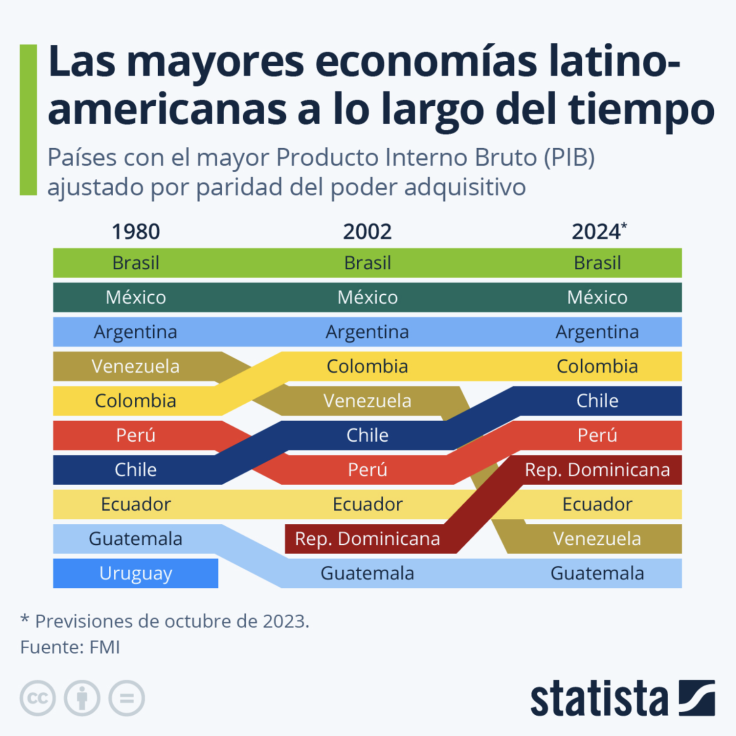
Brazil, Mexico and Argentina have had the largest economies in Latin America since at least 1980, and this won't change next year, according to a report from Statista based on IMF figures.
In 1980, Brazil's GDP was about $570 billion, Mexico's GDP was about $433 billion and Argentina's GDP was about $173 billion. In 2024, Brazil is estimated to have a total GDP of about $4.3 trillion, Mexico is estimated to reach about $3.4 trillion and Argentina is estimated to reach about $1.3 trillion.
For over 40 years, the three countries have remained at the top of the list, but the rest of the ranking has seen several changes.

Venezuela has been immersed in a deep economic, political and social crisis for about 10 years now. But even before that, in 2002, its economy was outgrown by Colombia, which overtook its neighbor at the 4th spot in the list.
In 2016 the country's GDP saw a sharp decline that took it Chile and Peru. As the malaise continued, the data from the IMF showed that in 2024 the country will be in ninth place, being overtook also by the Dominican Republic and Ecuador.
Although Argentina has kept its third spot on the list, its economy has been mostly stagnant over the past 10 years and more recently has been under increased pressure amid more than 100% inflation and a massive devaluation of its currency, the peso. Additionally, Argentina's population living below the poverty line increased from 36.5% in the first half of 2022 to 40.1% in the first half of 2023.
Despite its economic uncertainty, economy the IMF data still projects Argentina's GDP to keep growing, estimated to reach about $1.3 trillion in 2023 and $1.6 trillion in 2028.
Two Latin American countries which have had the most growth since 1980 are Chile and Dominican Republic. In 1980, Chile had a GDP of about $38 billion and was in seventh place for highest GDP. Since then, Chile went up to sixth place and now is in fifth place with a GDP of about $579 billion in 2022.
In 1980, Dominican Republic's GDP was not even top ten in Latin America, but in 2022, Dominican Republic with its GDP of $63 billion, landed in ninth place. Following that, Dominican Republic is now in seventh place, with a GDP of about $256 billion in 2022.
For the last five years, looking at IMF data showing Latin American country's GDP adjusted by purchasing power parity, in 2020, the year that the COVID-19 pandemic began, every single country besides one ended the year with a lower GDP than the year before. The one country which was able to increase their GDP was Paraguay. In 2019, Paraguay had a GDP of 92.64%, and then the following year in 2020, Paraguay ended the year with a GDP of 93.08%
Contrasting Paraguay, Venezuela's GDP was hit hard in 2020, and seems unable to recover quite yet. In 2019, Venezuela had a GDP of about $227 billion, the following year it dropped down to about $161 billion, which wasn't unusual compared to other countries. But, the contrast to other countries is that every other country, went back to about pre-pandemic GDP, or higher. For Venezuela, it dropped even lower than what it was pre-pandemic. In 2020, Venezuela ended the year with a GDP of about $170 billion, only a bit higher than 2020's $161 billion, but still $57 million short of the pre-pandemic GDP.
© 2025 Latin Times. All rights reserved. Do not reproduce without permission.





